Join us for conversations that inspire, recognize, and encourage innovation and best practices in the education profession.
Available on Apple Podcasts, Spotify, Google Podcasts, and more.
Look for the following topics in the video, indicated by the ![]() onscreen icon, and click below to learn more.
onscreen icon, and click below to learn more.
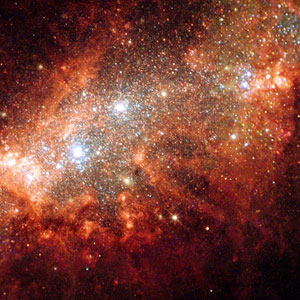 Star Formation |
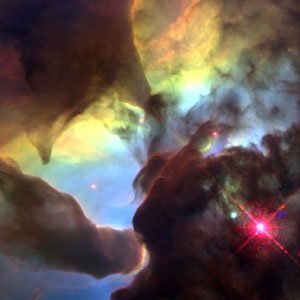 Extrasolar Planets |
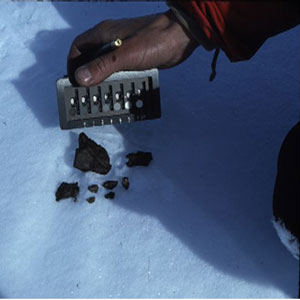 Meteorites |
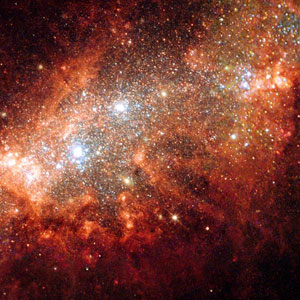
Star field.
The core then begins to collapse under its own weight, making it hotter and denser, and, as it gets smaller, it rotates faster in the same way that figure skaters spin faster when they pull their arms closer to their bodies. Once it begins to spin fast enough, the rotation of the gas and dust can keep material from moving toward the axis of rotation (the imaginary line about which all of the material is orbiting), but gravity keeps material falling along the axis of rotation. At this point, there is a flattened disk of material orbiting around a proto-star at the center of the disk. Some of the disk’s gas and dust will eventually fall onto the star, some will become the planets, moons, asteroids, and other objects that orbit the star, and some will escape the newly forming solar system. Eventually the solar system will settle into a state in which planets, asteroids, comets, and other bodies have stable orbits around the star, and the gas and dust have disappeared. This is the state of our solar system now.
It is possible for the core to fragment as it collapses, and the result is that more than one star is formed. In such cases, a disk of material can form around each star, around a multiple system of stars, or both. The formation of planets in such cases is not as well understood as planet formation is around an isolated star. Furthermore, it is important to remember that stars do not last forever. Eventually all stars run out of the fuel that allows them to shine, and they cool off and become less luminous, which has a significant impact on the planets orbiting the star. Fortunately for Earth, the Sun is expected to last for several billion more years before this is expected to happen.
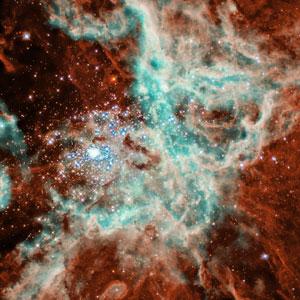
Extrasolar nebula.
One way to find a planet orbiting a distant star is to continually monitor the amount of light coming from the star. If a planet’s orbit brings it between the Earth and the star, the planet will block some of the light and, from Earth, it will look like the star becomes briefly dimmer. By determining how often this happens, the period of the planet’s orbit and its distance from the star can be determined. By measuring how much light the planet blocks, it is possible to determine its size, because a larger planet will block more light.
One problem with this method of detecting planets is that only large planets that orbit very close to their host star will block enough light for astronomers to be able to measure the fluctuations in the brightness of the star. As a result, the planets found with this or any other method developed thus far are all very large (about the size of Jupiter), and many of them orbit closer to their stars than the Earth is to the Sun. Since in our solar system the largest planets all orbit the Sun much farther out than the Earth, it is a challenge to understand why these systems are so different from our own. With the next generation of telescopes and satellites, astronomers hope to be able to detect Earth-like planets at Earth-like distances from their stars. At that time, scientists will be able to determine how common or rare it is for such massive planets to be able to form so close to their stars.
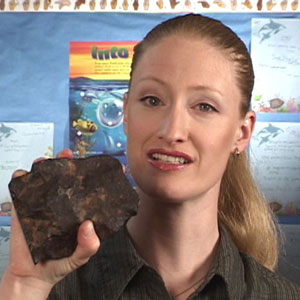
Britt holding a meteorite.
There are two kinds of places on Earth where meteorites are more likely to be found. One is on parts of the Antarctic ice cap where the ice flows together and evaporates in the sun and wind, leaving behind meteorites as a lag deposit. The other prime meteorite hunting ground is in deserts, where the dry conditions tend to preserve stones and the lack of rain means they are less likely to wash away.
Almost all meteorites come from the asteroid belt between Mars and Jupiter, where thousands of small, solid objects orbit the Sun. Some meteorites show geochemical signs of having been part of an evolving planet. Some are similar to basaltic rocks found on Earth. These basaltic meteorites are created by the impacts of other meteorites onto other bodies in the solar system, most commonly Mars and the Moon.